The latest round of beehive inspections has left me with sad news: it appears that both my hives are queenless, for whatever reason, and likely to not survive the summer. The strong one has a few queen cells, though, so there’s still hope. We were discussing the situation at the monthly beekeepers’ meeting last week, when the local hornet exterminator (a friend of ours) dropped in.
“I was just on a call up the Trask river today, and there’s a guy with a woodshed infested with honeybees,” He said, passing the buck. The homeowner’s wife thought they were yellowjackets, and called the wrong guy.
Everyone looked at each other, then pointed to me. “It’s your turn,” they said. “Besides, it looks like you’re going to need another colony pretty soon.”
Both scared and excited, I accepted the offer but explained that I would need some guidance, as I’d never extracted a feral colony before and I was also short on equipment. Terry, my beekeeping mentor, offered to let me borrow a hive top and base for the season. Bob, the president of the local club and probably the oldest guy present, offered the use of his bee vacuum (more on that later). “I’ll go along with ya, too,” he said, “As long as I don’t have to do any of the work.”
That’s how I found myself driving through the countryside, bright and early the next morning, with Bob’s blue pickup following. The directions were somewhat vague, in country-living style: follow the river road 12.5 miles, turn right at the abandoned green store, follow the gravel road to the end. After a few wrong turns, I discovered the gravel road in question, and was stopped by a friendly neighbor.
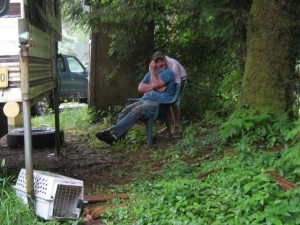 “You must be the bee guys!” he said with a toothy grin. Word gets around fast in these parts. “Keep on going; you’re almost there.” He tilted his head. “You mind if I bring a lawn chair and watch?”
“You must be the bee guys!” he said with a toothy grin. Word gets around fast in these parts. “Keep on going; you’re almost there.” He tilted his head. “You mind if I bring a lawn chair and watch?”
Bob and I parked our trucks, and I went in the house to introduce myself. The teenage daughter took me outside to show me the hive, which Bob had already found by himself. It was hard to miss, a six-inch knothole in the siding of the shed with a constant stream of bees coming and going. Our new friend Joel had already set up his lawnchair about 20 yards away.
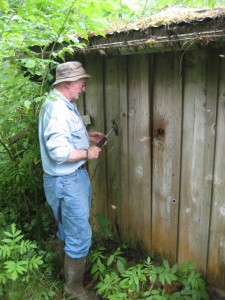 I went back to the truck and suited up, grabbed a prybar and smoker, and returned to find Bob already tearing siding off of the shed. So much for not doing any of the work. “Whooee, I’d get one of those suits on too!” Joel said from a safe distance.
I went back to the truck and suited up, grabbed a prybar and smoker, and returned to find Bob already tearing siding off of the shed. So much for not doing any of the work. “Whooee, I’d get one of those suits on too!” Joel said from a safe distance.
I shrugged. “These old timers, their blood is half bee venom anyway,” I said as I started helping Bob tear battens off of the wall. By now we could hear the bees really buzzing in there, and Bob muttered something under his breath. “You getting stung?” I asked, worried.
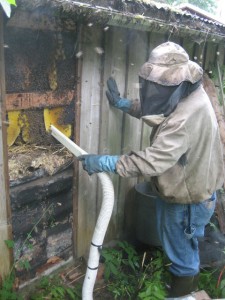 “Yeeep,” he drawled, as he slowly backed away. “Guess I’d better get my veil.” This is the part where I tell you about old beekeepers. I don’t know why it is, but most of them wear scant protection. Maybe it’s because they are bee whisperers, or maybe they’re immune, or maybe they have diminished pain receptors, but most of the old beekeepers I’ve had the pleasure to work with are VERY nonchalant about the protection issue. Neither Terry nor Bob wear gloves or coveralls, though Bob did wear dishwashing gloves today- a trick I will try next time, as my leather gloves were absolutely drenched with honey by the end of the day.
“Yeeep,” he drawled, as he slowly backed away. “Guess I’d better get my veil.” This is the part where I tell you about old beekeepers. I don’t know why it is, but most of them wear scant protection. Maybe it’s because they are bee whisperers, or maybe they’re immune, or maybe they have diminished pain receptors, but most of the old beekeepers I’ve had the pleasure to work with are VERY nonchalant about the protection issue. Neither Terry nor Bob wear gloves or coveralls, though Bob did wear dishwashing gloves today- a trick I will try next time, as my leather gloves were absolutely drenched with honey by the end of the day.
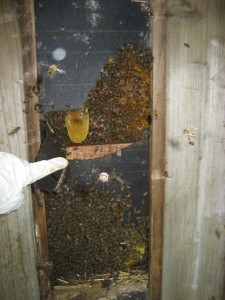 Bob returned with his jacket and veil about the time I got the main boards off the wall. WOW! Look at the size of that hive! (click on the image to enlarge it; check out he freeze-frame on the bee in the upper left) By now, there was a cloud of bees buzzing around us, and even more on the combs, eagerly gobbling all the honey they could due to the smoke I’d pumped in there. All told, the hive was about 30 inches wide, four feet tall, and four combs deep. A quick estimation led me to realize that there were three times the bees in this colony as both my hives put together.
Bob returned with his jacket and veil about the time I got the main boards off the wall. WOW! Look at the size of that hive! (click on the image to enlarge it; check out he freeze-frame on the bee in the upper left) By now, there was a cloud of bees buzzing around us, and even more on the combs, eagerly gobbling all the honey they could due to the smoke I’d pumped in there. All told, the hive was about 30 inches wide, four feet tall, and four combs deep. A quick estimation led me to realize that there were three times the bees in this colony as both my hives put together.
The click and hum of the bee vacuum brought me back to the present, and Bob began sucking up bees. The bee vac is a clever device; it has a vacuum motor attached to a plywood box, about three feet square and two feet high. Within this plywood box is another plywood box, with steel mesh sidewalls. A wide vacuum hose with angled tip, much like you’d see on a shop vac, passes through the sidewall of both boxes. To use it, you simply suck up bees just like so many dustbunnies on your living room floor. The bees fill up the inner box, and you can remove it to transport it to the bees’ new home.
As Bob sucked up the hapless bees, I cut out comb after comb from the wall cavity. They were loaded with both honey and brood, so I took the largest ones and laid them down on a board. With my hive knife, I cut them down to fit into the frames of their new home: a portable beehive that I’d brought with me. Four of the best combs were saved; the rest went into two 5-gallon buckets.
You can see a video of it HERE, since I can’t get the embedded code to work…
After a few hours, we’d cleared the wall of bees and comb. I clamped the portable hive together with a pair of ratchet straps, and sealed the entry with some steel mesh to trap in the bees that had already moved in. As I loaded it into my pickup, Bob opened the bee vac and pulled out the interior plywood-and-screen box, humming with bees. Judging by the weight of it, it held about 30,000 bees. The box itself looked like it’d seen some hard use; the nails on the sides were loose, the wood was severely weathered, and Bob had sealed the entry with two pieces of duct tape.
“Don’t leave them till morning; you better take ’em home now or they’ll overheat and die,” he advised as he set the buzzing box in the back of my pickup with all my equipment. I closed the hatch and we took off our suits. “I’ll see you back here at about 9pm to get the rest of them.” Um, what? Turns out, you have to do this TWICE, returning a second time in the evening as well to get all the bees that are away from the colony foraging during the day.
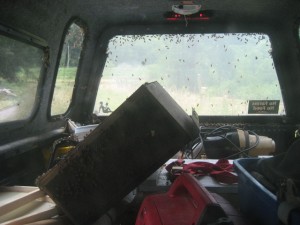 My mind was racing with all the stuff I had to do as I was bouncing down the country roads back to the farm. Get some weatherproof wood from the scrap pile, make a new hive stand, level the stump I was going to place it on, pop into the hardware store to get some lag bolts, grab a quick sandwich and an empty super at home… then I happened to glance in the rear view mirror. Apparently, the turns and bumps of the road had jiggled something loose, and there was a crack in the bee box. Oh dear.
My mind was racing with all the stuff I had to do as I was bouncing down the country roads back to the farm. Get some weatherproof wood from the scrap pile, make a new hive stand, level the stump I was going to place it on, pop into the hardware store to get some lag bolts, grab a quick sandwich and an empty super at home… then I happened to glance in the rear view mirror. Apparently, the turns and bumps of the road had jiggled something loose, and there was a crack in the bee box. Oh dear.
As I went about all these errands, I saw more and more bees whirling around in the back of the truck with each passing minute. Thank goodness I don’t drive a van! I chuckled to myself as I went into the hardware store without locking the back of the truck; anyone opening it to steal my tools would be in for a REALLY unpleasant surprise. By the time I finally got to the farm, the fog of bees in the back of the truck was pretty thick, and many of my tools were carpeted with bees. I don’t know how I got so lucky, but I had accidentally thrown my bee suit in the front seat of the truck, instead of the back where I normally leave it.
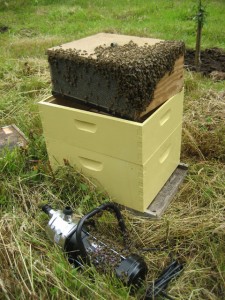 After donning my bee suit, I opened the back and got to work. I must have been quite a site, moving the traveling hive, hive parts, and various pieces of bee-covered equipment out to the middle of the orchard surrounded by a giant cloud of insects. After a little quick carpentry, I had the hive stand in place with hive on top, and I poured in the bees.
After donning my bee suit, I opened the back and got to work. I must have been quite a site, moving the traveling hive, hive parts, and various pieces of bee-covered equipment out to the middle of the orchard surrounded by a giant cloud of insects. After a little quick carpentry, I had the hive stand in place with hive on top, and I poured in the bees.
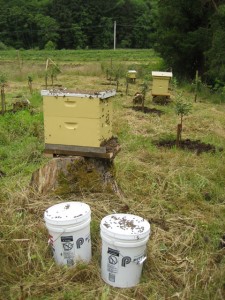
A quick sandwich and short break later, it was time to head back to meet with Bob to get the remaining bees. We rode out together in my truck this time, and as we were chatting about this and that I couldn’t help but think about what an under-valued asset the elderly are to our society. He has a lot of knowledge in that head of his, and he was spending much of his day giving a part of it to me and asking nothing in return… maybe because he was bored or lonely, maybe because he takes pride in his expertise, or maybe just because passing along such secret wisdom to an eager listener is the right thing to do for the sake of humanity.
Sucking up the remaining bees was almost anticlimactic, which really puts things in perspective, because this time last year I would have thought catching a few thousand bees a pretty scary experience. Bob let me do most of the work as he chatted with the neighbors; he didn’t even put on his suit. “Make sure you let the bees out first thing in the morning,” he warned me, “or they’ll overheat and die.”
I thought of this and many other things as I was driving home in the dark at about 10pm, a very tired beekeeper.
* * *
Postscript
That long day of beekeeping was just the beginning of the work. In the next few days, the two five-gallon buckets yielded almost two quarts of tasty honey and quite a bit of wax that will likely be used for waxing bowstrings and making candles. My last task was to return Bob his bee vac. He gave me some pretty vague directions to his house, but as soon as I saw it I knew I’d found the right place:

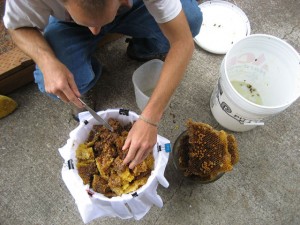
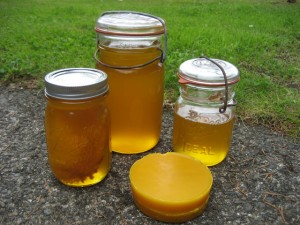
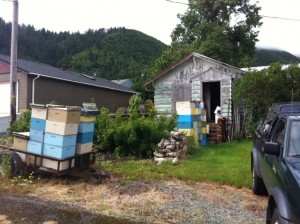

One Response to Collecting a feral bee colony